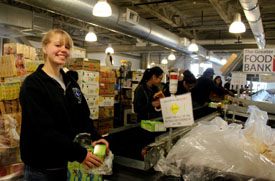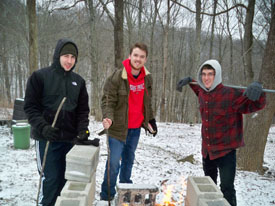Winter, spring programs immerse students in the world of social advocacy
This spring, a dozen or so Rutgers students are heading to West Virginia to make children laugh.
They’ll be volunteers at the Gesundheit! Institute, which helps sick youngsters heal through clowning, gaming and just plain fun. Other Rutgers students will travel north, to Greenfield, New Hampshire, to work with clients of Crotched Mountain, a resource for individuals with disabilities and their families. Or south to Baltimore, to volunteer with the nonprofit Teach for America to address inequalities in urban education.
Some 143 students will take part in the university’s Alternative Winter Break and Spring Break program, which offers undergraduates the opportunity to save the world, one community at a time.
“Each trip is a way to learn about your country in a different way,” says Jay Chopra of Union, a senior English major in the School of Arts and Sciences. “It’s a way to totally immerse yourself in the environment – and come away changed.”
Sorting through sacks of potatoes and packing non-perishables might not be everyone’s idea of a holiday, Rutgers’ College of Nursing senior Caitlin Kenny acknowledges, especially during those precious free weeks before exams, lab reports and term papers. But the five days the Old Bridge resident spent working with the hungry and homeless at the Bread for the City food bank in Washington DC as part of the program proved to be food for the soul, as well as for the mind.
“Once I got involved, I never stopped,” Kenny says.

In January, Kenny will head west to coastal California to take part in her fourth community service project under the program’s sponsorship: A week at the Catalina Island Conservancy, where she and a dozen other Rutgers students and staff will build fences and maintain trails in the oldest private land trust in the Golden State.
What keeps her coming back – and what seems to attract the 550+ Rutgers students who have signed on to the winter, spring and weekend programs since their inception seven years ago – is the opportunity to experience community life both near and far, on more than a superficial level.
“The people I’ve met through these trips have changed my perspective,” says Chopra. “They’re fully invested in their communities, they’re grounded and motivated – good people to be involved with.”
Chopra’s first taste of the program was a stint last year with Heart of Camden, a nonprofit church-based social ministry providing housing to people of limited means. He and his classmates spent half their time tutoring children in Camden and the remainder visiting with homeless men in Philadelphia’s Center City neighborhoods.
In January, Chopra will take his advocacy to Maryville, Tennessee, to work on ecological projects in a Cherokee community via a wilderness retreat known as Once Upon a Time in Appalachia. As part of his preparation, he has attended required meetings this semester to learn about Cherokee history and to gain insight into that population’s culture and customs.
Karen Ardizzone is associate director of student involvement and community services initiatives in the Rutgers Department of Student Life and a founder of the Alternative Break program. She says New Orleans has been a popular destination since Hurricane Katrina. Plans are under way to add a New Jersey shore component this spring in the wake of Hurricane Sandy.

Suggestions for venues come from the students themselves, Ardizzone says. Among the criteria are the potential for community service on the ground, what lessons participants can expect to take away from the experience – and whether the site has a kitchen and a bathroom.
Ardizzone was an advisor on the first trip, in 2006, to West Virginia. During their stint in Fayette County, a coal mining region in the south-central area of the state, the 13 students rehabbed houses, landscaped yards and interacted with volunteers at the Southern Appalachian Labor School in Beard’s Fork.
Upcoming trips cost from $150 for a weekend in Kimberton, Pennsylvania, helping disabled people gain skills through gardening and cooking, to $450 for a week in Chicago partnering with Year Up, which helps inner-city students with technological and social skills.
New this year is a May trip to Guatemala -- the program’s first international venture and a chance for participants to work side-by-side for a week with that country’s coffee farmers. Participants will pair with As Green as it Gets, a community organization helping communities grow beyond sustenance farming and become active in the fair-trade market.
Some scholarship aid is available for the break programs, and participants also do fund-raising throughout the year, Ardizzone says.
During and after their immersion in the alternative breaks program, many of the participants contribute to a blog in which they describe not only their experiences, but also their reactions to interacting with the beneficiaries of their advocacy. Wrote Christina Kelly and Nikita Patel about their work last March with the hungry in Washington: “How does one describe the realization that the very place we came to enact positive change upon simultaneously enacted positivity on us?”
Program veterans have gone on to jobs with Catholic Charities, the Peace Corps, Teach for America , the U.S. Army and City Year, among other career choices.